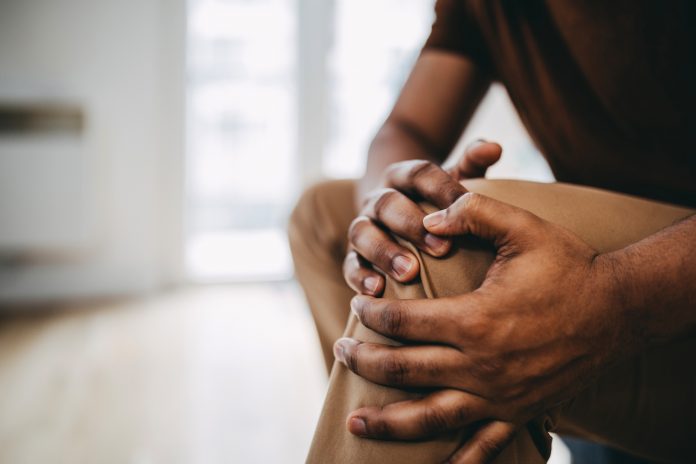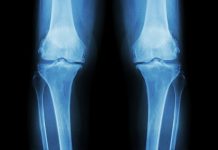With ten million people in the UK alone suffering from osteoarthritis, Dr Deborah Lee explains the prevalence of the condition, the common risk factors, and preventative measures
Osteoarthritis (OA) is a serious, degenerative disease that significantly impacts a person’s ability to live and work. It is the most common type of joint disease worldwide.
Joint deterioration in OA occurs due to cartilage breakdown, inflammation, roughening of the articular surfaces, the development of osteophytes (bony spurs) and damage to surrounding ligaments.
The most common symptoms are pain – especially on movement – stiffness, loss of function, joint swelling and deformity.
Ten million people in the UK are currently suffering from OA. 5.4 million people have OA of the knee, and 3.2 million have OA of the hip. Furthermore, one in ten UK adults has symptoms and clinically confirmed OA, most often affecting the knee.
OA prevalence
OA prevalence is affected by age and sex. It also affects some joints more commonly than others. The risk of OA increases with age, affecting 18% of women and 10% of men aged over 60. The National Institute for Health and Care Excellence (NICE, 2022) recently reported that between the ages of 45 and 64, around one-third of women and one-quarter of men have sought help for OA. This figure increases with age, meaning almost half of those aged 74 and over are affected.
OA is more common in women than men. For example, OA of the hip affects almost twice as many women as men.
OA can affect any joint but most commonly affects the knee, the hip, the hands and the wrists, in that order. The spine is also commonly affected, OA being the most common type of arthritis to affect the spine. Interestingly, OA does not always cause pain and may only cause stiffness and loss of joint function.
OA risk factors
Risk factors for OA can be divided into modifiable and non-modifiable. These are described below:
Non-modifiable risk factors
- Genetics: Research shows that 40-70% of cases of OA are due to a genetic abnormality, such as a gene mutation that affects the growth and repair of bone and cartilage. Studies have found the radiological changes of OA in the joints are much more similar in mono than in dizygotic twins. Regions of specific chromosomes have been identified that contain OA susceptibility genes such as the COL2A1, FRZBG gene and IL-1R1 genes – but more research is needed.
- Musculoskeletal abnormalities: Some congenital malformations, such as subluxation of the hip or slipped femoral epiphysis, increase the risk of OA because they affect the biomechanics of the joint.
Modifiable risk factors
- Obesity:
- Research has shown a significant correlation between obesity and the risk of developing OA. Each 5kg of weight gain increases the risk of knee OA by 36%. Conversely, losing weight reduces the risk of OA. In the Framingham study, women who had lost 5.1kg of weight in the ten years before the study had a 50% reduction in the risk of developing OA of the knee. The reasons for this are complex. In obesity, fat mass exceeds muscle mass. Mechanical forces on the joint cause the release of proinflammatory cytokines and enzymes such as interleukin (IL)-1beta, cyclooxygenase-2, prostaglandin E2, and matrix metalloproteinase, which lead to inflammation, cartilage degradation and destruction of the proteoglycans and collagen that form part of the extracellular matrix.
- Muscular weakness:
- Weak muscles have been shown to be associated with knee OA. Other studies have linked weak grip strength to OA of the hand. Knee joint laxity – caused by weak knee ligaments – is also a risk factor for OA of the knee. This can result from injury to the knee joint.
- Occupational exposure:
- It is well recognised that those who use their joints repetitively for work purposes have a higher risk of OA. Farmers, floor layers, builders and metal workers have a higher risk of hip OA – presumably from repetitive bending, straightening, and carrying heavy weights on the hips. Firefighters, builders, miners and those in the forestry industry have an increased risk of knee OA due to increased stress on the knees.
- Sports:
- The effects of sport on the risks of OA are not well understood. Whereas many studies show sports increase the risk of OA, being physically active when diagnosed with OA helps relieve symptoms and improves physical function. Sports that increase the risk of knee OA include football, long-distance running, competitive weightlifting, and wrestling.
- Hormones:
- The link between oestrogen and OA is unclear. OA symptoms may first appear or worsen in women after the age of 50 when menopause occurs, and oestrogen levels plummet. Several studies have linked low oestrogen levels to the onset of OA. Bone and cartilage contain oestrogen and progesterone receptors.
- Oestrogen is known to play a role in the production of proteoglycan, lower inflammation and neutralise free radicals, lowering oxidative stress. Studies on the use of HRT and OA have had conflicting results. However, some have shown that using exogenous oestrogen helps maintain healthy cartilage and stimulates bone turnover. HRT seems most effective on joints if started early in the menopausal transition. In joint protection, there is no difference in oestrogen-only or combined HRT (oestrogen plus progesterone).
- Diet:
- Eating an anti-inflammatory diet is the best way to prevent OA. This means eating large amounts of fruit and vegetables, which contain health-giving antioxidants, plus plenty of vitamin D and K, and high in fibre.
- Antioxidants counteract the dangerous effects of reactive oxygen species (ROS) produced in oxidation, which can damage DNA. Vitamin D is required for muscular strength and balance. During the winter months, all UK adults are recommended to take a vitamin D supplement. Vitamin K is needed for bone building and is found in green vegetables and eggs. Fibre is vital for a healthy microbiome, influencing bone and cartilage metabolism.
- Avoid inflammatory foods – ultra-processed and processed foods, white foods, snacks, deep-fried food, takeaways, and foods high in fat, sugar, and salt.
How can osteoarthritis impact a person’s quality of life? What are the potential health complications associated with the condition?
OA affects both physical and mental health. Pain, stiffness, and restricted movement are significant causes of disability. Living with osteoarthritis interferes with the ability to work, sleep, travel and participate in normal social functions.
Depression is common, affecting 20% of OA sufferers. Being depressed exacerbates pain and further limits mobility, hence worsening OA symptoms. This then increases depression and creates a vicious circle.
OA is also a cause of loneliness because it increases the risk of social isolation, and loneliness has severe consequences for long-term health. Being lonely is as bad for health as smoking ten per day.
What treatments are available for osteoarthritis?
There is no single treatment or cure for OA. Management means treating the symptoms as best as possible to minimise their severity and maximise joint function. Below is a list of different treatment options.
- Exercise:
- Patients need to understand that even though their joints are painful, they need to keep moving. The disuse of joints increases pain and stiffness. Exercise is beneficial as it stimulates the circulation. Bringing oxygen to the tissues and removing waste products. Taking the joint through its motion ensures the muscles and ligaments are regularly stretched and strengthened, improving flexibility. It also uses up calories, aids weight loss, and provides cardiorespiratory exercise, lowering blood pressure and increasing physical fitness.
- The current recommendation is 150 minutes of moderate-intensity exercise per week – this is exercise sufficient to make you feel a bit sweaty and interrupt your ability to talk. Good options are walking, jogging, cycling, and swimming. Swimming is especially beneficial as the water takes the weight, taking the pressure off the joints, and the hydrostatic pressure of the water exerts a positive force onto the joint, reducing joint swelling. Why not try Let’s Move with Leon, an online exercise plan developed by Versus Arthritis? For those with severe symptoms, physiotherapy may be needed. Hydrotherapy is especially beneficial.
- Medication:
- There are currently no disease-modifying drugs for osteoarthritis, although research is underway. Treating OA relies on treating the symptoms and trying to alleviate the possible underlying causative mechanisms. Nonsteroidal anti-inflammatories (NSAIDs) are the first line of treatment. NSAIDs are cyclooxygenase inhibitors. These switch off the production of prostaglandins that cause inflammation in the joints. Ibuprofen, naproxen, and diclofenac are commonly used, sometimes in slow-release preparations or as a gel rubbed into the skin overlying the joint, to minimise gastric irritation. Long-term NSAIDs are frequently prescribed along with a proton pump inhibitor such as omeprazole to help prevent the onset of gastritis and stomach/duodenal ulceration. There are two types – Cox-1 inhibitors and Cox-2 inhibitors. Cox-2 inhibitors (Celebrex) have advantages in that they block Cox-2 more than Cox-1, resulting in fewer gastrointestinal side effects.
- Acetaminophen (paracetamol) has not been shown to be a very effective analgesic in OA; however, for those who cannot take NSAIDs or have not responded well, it is an alternative and can be helpful for some.
-
- Steroids such as hydrocortisone, dexamethasone or triamcinolone can be injected into an OA joint as these are powerful anti-inflammatories. This can give good symptomatic relief for several months, but this is not always the case. In some patients, it seems to make the pain worse. Repeated steroid injections can dampen the immune system, so this is not usually used as a long-term strategy.
Other treatments for osteoarthritis
- Capsaicin:
- Studies show that topical capsaicin – the chemical in chilli peppers that gives them their hot taste – is effective in reducing OA pain and can reduce pain by up to 50%. It is thought to work by blocking the production of Substance-P, a protein found throughout the nervous system that is important in transmitting the pain sensation.
- TENS machine:
- Transcutaneous electrical nerve stimulation (TENS) machine is a device in which electrodes are placed on the skin and produces an electrical current that stimulates the production of brain endorphins – the brain’s natural painkillers. In a 2015 Cochrane review, half of OA sufferers who used TENS obtained around 50% pain relief.
- Hyaluronic acid injections:
- Hyaluronic acid (HA) is found in joint fluid, keeping the joint well lubricated. In OA, the articular surfaces of the joints become roughened, and levels of HA are depleted. HA can be injected into an affected joint. However, the NHS does not currently recommend this as results from clinical studies are inconclusive. It can be done privately and can help some patients some of the time.
- Glucosamine:
- This is an amino sugar found naturally in healthy cartilage. In a 2018 systematic review and meta- analysis, which included 18 studies, glucosamine was slightly better than a placebo at relieving pain, and the authors recommended it as a supplement for long-term use. However, they recommended it be given as glucosamine sulphate and chondroitin sulphate as the two work synergistically.
- Fish oil
- Fish Oil is a rich source of omega-3 fatty acids – docosahexaenoic acid (DHA) and eicosapentaenoic acid (EPA). These are also found in fatty fish such as salmon, mackerel, trout, sardines and anchovies. These omega-3 FAs have potent anti-inflammatory properties, are powerful antioxidants and help regulate immune function.
- OA sufferers should eat two or consider taking a fish oil supplement. It’s important not to have too much fish oil as it contains high levels of vitamin A, and too much vitamin A can cause liver toxicity. Plus, fish oil can contain heavy metal contaminants from the sea. Studies have so far not proven a benefit from taking fish oil supplements.
- Collagen peptides:
- Hydrolysed collagen – collagen peptides – may also be helpful for OA sufferers. Research studies have confirmed that these orally administered hydrolysed collagen peptides do accumulate in cartilage within the joints and stimulate chondrocytes to produce more cartilage.
- In one 2014 randomised placebo-controlled study, for example, after 13 weeks, those who took the peptides had a significantly better improvement in pain and quality of life score than those taking the placebo. The authors recommended collagen peptides could be used in OA management and joint health.
Complementary therapy
- Massage:
- In a 2022 review of 12 studies, a massage resulted in a significant reduction in pain and stiffness and improvement in functionality. Aromatherapy massage resulted in a significant reduction in stiffness. Patients were studied for up to eight weeks of treatment. Massages stimulate blood flow and ease the muscles and ligaments surrounding the joint. They reduce muscular tension and help reduce joint swelling.
- Acupuncture:
- This has been used for centuries for many medical conditions. Once the acupuncture needle is correctly placed, it sets off a cascade of reactions, triggering the release of endorphins. Many patients get good relief from acupuncture. However, a 2016 Cochrane review of the use of acupuncture in OA failed to find any significant symptomatic improvement. In other studies, 50% of patients using acupuncture for chronic pain have experienced relief as opposed to 42% of those using a placebo. It is well worth trying acupuncture if symptoms are difficult to manage.
- Tai Chi:
- In a 2003 study comparing a group of women with OA who did Tai Chi for 12 weeks with those who did standard exercise for 12 weeks, those who did Tai Chi had a 30% pain reduction and were found to have a 30% improvement in their ability to carry out daily functions. Tai Chi improves flexibility, muscle power and posture, as well as exercising the cardiovascular system.
Surgery:
-
- The NHS performs around 100,000 knee replacement operations annually in the UK. In one study, 33% of patients with knee OA had a total knee replacement. Knee replacement is considered a safe, generally effective procedure.
- The NHS carried out eighty-five thousand hip replacements in England, Wales and Northern Ireland in 2021. Around one in ten people with hip arthritis will choose to have a hip replacement within ten years of seeing a specialist. This means nine out of ten manage their hip symptoms by alternative means.
- Hand surgery may be required for those with severe hand symptoms. This might be an arthroplasty to replace a damaged joint and replaces it with a silicone implant. Alternatively, arthrodesis means fusing the bone, which often removes the pain but results in loss of movement of the joint.
- OA in the spine causes facet joint arthritis, also known as degenerative spinal disease. This can cause severe pain and sometimes results in increased pressure on the cord due to spinal stenosis – a narrowed spinal canal. Spinal surgery, such as a laminectomy and/or spinal fusion, may be needed.
Can lifestyle changes prevent osteoarthritis?
Yes, many lifestyle changes can be made to reduce the onset and severity of OA. It is important to do all of the following:
- Take regular physical exercise:
- A 2015 systematic review, including evidence from 55 good-quality studies, concluded that taking regular land-based exercise reduces pain and severity for those with mild to moderate knee OA symptoms. The degree of pain relief was similar to that achieved from taking standard NSAIDs, with long-term benefits in improved physical function.
- Maintain a healthy weight:
- Many studies have shown that weight loss improves OA symptoms. In a recent 2021 review of 30 studies, the most effective weight loss treatments were bariatric surgery, a low-calorie diet, and intensive weight loss with exercise. The authors found that for each 1% of weight loss, there was a 2% reduction in pain, stiffness, and function. A 25% weight loss is needed to obtain a 50% reduction in the pain score. They pointed out that physical exercise is imperative during weight loss to avoid sarcopenia – loss of muscle strength.
- For patients with OA and morbid obesity, bariatric surgery should be considered a realistic alternative to knee replacement surgery.
- Control blood glucose levels:
- Knee OA is caused by inflammation. Patients with knee OA often have raised levels of C-reactive protein and cytokines such as IL-6, IL- 1β, and tumour necrosis factor-alpha (TNF-α). Eating large amounts of carbohydrates can lead to the formation of advanced glycation end products. These processes slow cartilage repair and regeneration and are linked to increasing pain. A high carbohydrate diet can, therefore, exacerbate inflammation and worsen OA.
- In one 2020 randomised controlled study, a group of adults aged 64-75 with knee OA were randomised to a low carbohydrate diet or a standard diet for 12 weeks. The low-carb diet group exhibited a significant improvement in pain and quality of life compared to those on the standard diet. There was no weight loss between the two groups, leading the authors to believe this was due to the lowering of oxidative stress and inflammation.
- Eat low-sugar foods:
- Plenty of fresh fruit and vegetables, and high-fibre foods, including lentils and beans. Choose foods with a low glycaemic index. Avoid fruit juices and sugary, fizzy drinks.
- Reduce your alcohol consumption:
- The effects of chronic alcohol intake on OA are not well understood. However, in a recent 2022 prospective study of 2,846 participants without knee OA, who were followed up for 96 months, the risk of OA was doubled in those who drank 30g of alcohol per day (approximately two drinks a day) compared to non-drinkers. Alcohol causes systemic inflammation, as evidenced by a raised C-reactive protein level. In animal studies, alcohol results in accelerated cartilage loss from joints.
- Get enough sleep:
- A 2021 case-control study of 351,932 adults concluded that patients with sleep disorders were 25% more likely to have OA. Sleep disorders included sleep apnoea and hypersomnia (excessive sleepiness and sleeping for longer at night).
- 70% of OA sufferers have some type of sleep disorder, most often insomnia and sleep deprivation, due to depression, anxiety and pain. Sleep deprivation is associated with an increase in inflammatory markers. See your GP to discuss your sleep and anything that can be done to improve your sleep quality.
- De-stress:
- Stress of any kind, including pain, stimulates the sympathetic nervous system, releasing adrenaline and cortisol. The body is prepared for ‘fight, fright and flight’ and is tense, with a rapid heartbeat, raised blood pressure and starts to sweat.
- If you can destress and switch off the SNS, this will all calm down, with a slower heart rate, lower blood pressure and feelings of calmness and relaxation. As the parasympathetic nervous system swings into action, many symptoms will be reduced, even pain.
- Stress levels can be reduced in many different ways. Make time for rest as a priority, not an afterthought. Meditation, mindfulness, and breathing exercises are good options. Other techniques include hot and cold therapy, yoga, acupuncture and Tai Chi.
To what extent can research and development of innovative technologies improve treatment and care for people affected by bone, joint and muscle disorders?
New research is urgently needed to help OA sufferers around the world. Catching the disease early and preventing joint damage as early as possible would be expected to reduce the pain and suffering of the disease. Here are some examples of new research developments:
- Injectable cell therapy:
- Scientists have found that cells retrieved from the synovial fluid from a joint with damaged cartilage are not adequately equipped to do the repair. However, in rats, when researchers retrieved these cartilage cells and modified them to create ‘anti-inflammatory cartilage-activated T-cells’, the cartilage was successfully repaired. In humans, this technology has been used on nine patients with OA, and MRI scans have confirmed cartilage regeneration. More studies are indicated.
- Decrease in klotho – a longevity protein:
- Stiffening of the extracellular matrix has recently been associated with decreased levels of a newly discovered longevity protein known as klotho.
- This has been found to protect the mitochondria in skeletal muscle and be important in muscular repair and regeneration after an injury. Klotho levels naturally decline with age. Scientists are interested in whether they can alter klotho gene expression and improve the health of articular cartilage.
Disease-modifying drugs:
-
- Recent interest has centred on the drug talarozole, which may be effective for those with hand OA. Talarozole is a retinoic acid metabolism-blocking drug (RAMBA) that causes an increase in retinoic acid in the joints. This seems to reduce joint inflammation and damage to cartilage. Recruitment for a clinical trial began in January 2023.
Are there any notable developments or current issues in osteoarthritis research or treatment?
Much research is being undertaken to try and find an effective prevention or treatment for OA. Below are two important discoveries.
- No current recommendation for stem cells in OA:
- Although the idea is promising, trials have not shown them to be safe and effective so far. To date, mesenchymal stem cells have been used that originate from a patient’s own blood, fat or bone marrow – but these are not regarded as true, live stem cells. These sorts of cells have not been shown to cause cartilage regeneration.
- Ultrasound treatment for OA:
- In a 2018 study, 90 patients with moderate to severe knee pain were randomised to receive four hours of ultrasound treatment per day for six weeks or a placebo. Pain and function were significantly improved in the ultrasound group at the end of the study. In animal studies, ultrasound enhances the effects of type-2 collagen to improve the strength of the extracellular matrix, although whether this effect occurs in humans is not known.
Final thoughts
OA is more than just a nuisance and a few aches and pains. When patients present with symptoms and signs of OA, these need to be taken seriously and all steps taken to modify the progression of the disease.
There is no single cure or one-step approach for all. Each patient needs to be considered in the context of their own medical history and lifestyle factors. As is often the case in medicine, prevention of OA is better than cure.
- What new advice can you offer patients with symptoms of OA?
- Which new approaches might help slow the disease progression and help them remain active and mobile?
Patients who want to participate in clinical trials for OA can find out more by clicking here.
For more information
- Versus Arthritis – Osteoarthritis
- British Dietetic Association (BDA) – Osteoarthritis and diet – Food factsheet
- WebMD – Weight loss strategies for osteoarthritis
- Physiospot – Hydrotherapy for knee osteoarthritis













